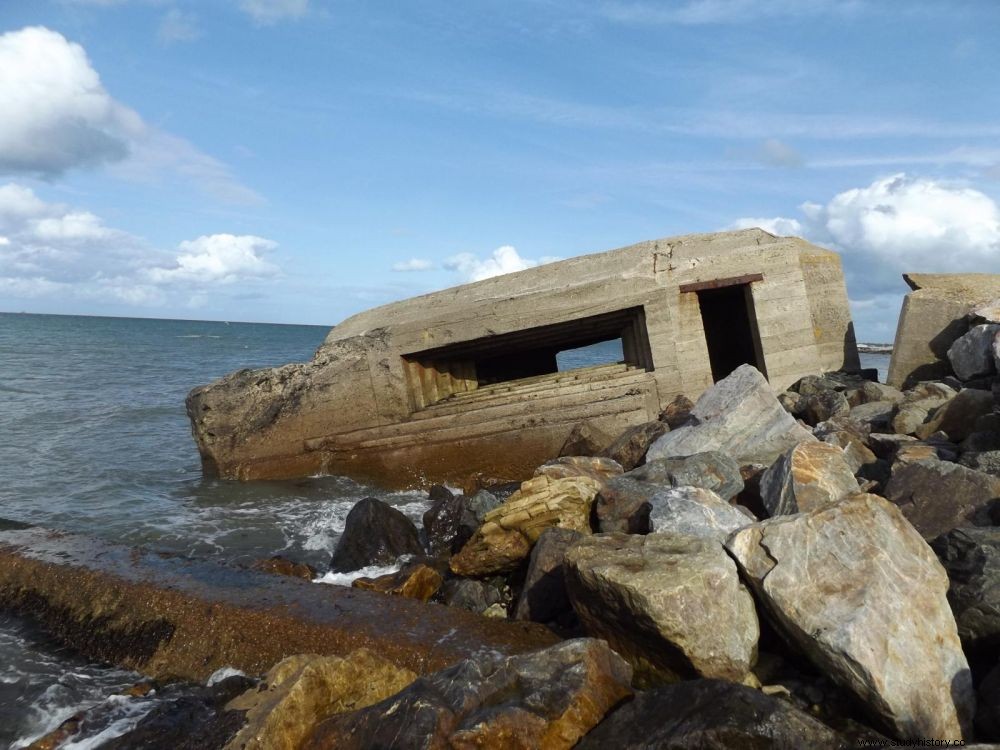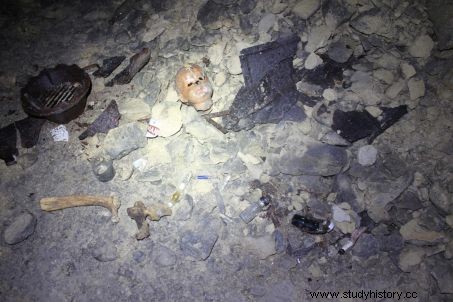Recently, archaeologists have been interested in contemporary times and the Allied landings of June 1944. A past whose traces are inexorably fading.

Blockhouse of the Atlantic Wall, on the Normandy coast.
The excavations of the site of Pegasus Bridge, north of Caen (Calvados) have just been completed recently. This bridge over the Orne is the symbol of the entry of the Allies into the Battle of Normandy during the landing of June 6, 1944:it was taken by the first British troops of the 6th Airborne Division and immortalized in the cinema by the film "The Longest Day by Darryl F. Zannuck, released in 1962. Today it is one of the objects of study by archaeologists, who at the same time carry out the complete inventory of the 3000 blockhouses (fortifications) of the Atlantic Wall put in place by German troops along the coastline. Inside the Normandy bocage, specialists also study the battle sites of the last world war, considered as new fields of study for preventive archeology, as a counterpoint to historical research.
“Archaeologists are there to take over from this fading memory »
“It's not all in the lyrics, explains Vincent Carpentier, archaeologist from the National Institute for Preventive Archaeological Research (Inrap), interviewed by Sciences et Avenir . We unearth the details of some known episodes, others less known, and thus contribute to the enrichment of the fabric of history for the Battle of Normandy and its theaters of military operations ". It is also a way of consolidating the memory of events that tend to fade from memory with the gradual disappearance of witnesses, as was already the case for the First World War. “Archaeologists are there to take over this fading memory “says Vincent Carpentier.
The excavations of the site of Pegasus Bridge, north of Caen (Calvados) have just been completed recently. This bridge over the Orne, symbol of the entry of the Allies into the Battle of Normandy during the landing of June 6, 1944, was taken by the first British troops of the 6 th airborne division. Immortalized in the cinema by the film "The Longest Day by Darryl F. Zannuck, released in 1962, it is now one of the objects of study by archaeologists, who at the same time are carrying out the complete inventory of the 3000 blockhouses (fortifications) of the Atlantic Wall put in place by German troops along the coastline. Inside the Normandy bocage, specialists also study the battle sites of the last world war, considered as new fields of study for preventive archeology, as a counterpoint to historical research.
“Archaeologists are there to take over from this fading memory »
“It's not all in the lyrics, explains Vincent Carpentier, archaeologist from the National Institute for Preventive Archaeological Research (Inrap), interviewed by Sciences et Avenir . We unearth the details of some known episodes, others less so, and thus contribute to the enrichment of the fabric of history for the Battle of Normandy and its theaters of military operations ". It is also a way of consolidating the memory of events that tend to fade from memory with the gradual disappearance of witnesses, as was already the case for the First World War. “Archaeologists are there to take over this fading memory “says Vincent Carpentier.

Shell casings. Remains of a British artillery position found near Pegasus Bridge, in Blainville-sur-Orne (Calvados). © E. Ghesquière / Inrap.
A race against the elements. Along the coast, the bunkers are gradually disappearing under the onslaught of the sea, coastal erosion and urbanization. The same applies to the remains of field hospitals, prison camps or other sites on the Orne estuary. By comparing the remains excavated with aerial photographs or testimonies recorded in military archives, these traces refine our knowledge of these significant events. "We were thus able to unearth elements of the "gliders of the Orne", these unique prototype aircraft that the Anglo-Canadian divisions used to liberate Caen while the Americans landed on the beaches of Omaha Beach to head towards Cherbourg. These offensives required an extraordinary logistical effort with the use of equipment that was totally innovative at the time adds Vincent Carpentier.

Roundel of a British RAF Horsa glider found at the Blainville-sur-Orne site, taken June 6, 1944. © Vincent Carpentier /Inrap
In Fleury-sur-Orne, a small town located south of Caen, the archaeologists were also able to study the camps occupied by these same Anglo-Canadians who had to face for several weeks the SS panzer divisions of the III e Reich locking down the south of the city. Episodes which, if known, are still poorly documented. “We unearthed shelters, evidence of soldiers burying themselves like in the First World War, and a motley heap of ammunition, sandbags, helmets and personal items “, continues the specialist. For the first time, the medieval limestone quarries that served as refuges could also be explored and are currently the subject of a 3D laser survey (photo).

Fleury-sur-Orne, 3D scanner of one of the spans of the "Saingt" quarry. © Cyril Marcigny
They are proof that the population of Caen, terrified by the bombings, had withdrawn there (see box). “The entrance to one of these dungeons had been sealed since the end of the war. We discovered there precarious installations put in place by the families to survive:the remains of straw mattresses, many children's toys that had to be occupied during these long hours of anguish, but also medicines or medical equipment. military origin proving that the Canadians had provided medical assistance after the liberation of the city. We also found objects abandoned by the German troops who, at the height of the bombardments, had come to dislodge the civilians to take refuge there in their turn. »

Child's toy, brazier and medical products found in one of the spaces occupied by civilians in the Saingt quarry in 1944. The bones are the remains of the fauna consumed. Often these were animals killed in the bombardments, which the refugees scavenged for food. ©Cyril Marcigny / Inrap
This archaeological research on "modern" sites, in full development in the world, also makes it possible to limit the possible "rewritings" of History and the manipulation of certain facts. For example, Caroline Sturdy Colls, a forensic anthropologist at the University of Staffordshire (United Kingdom), has been studying the locations of concentration camps since 2014. She thus exhumed in Poland material traces of the Treblinka camp, an extermination site whose existence some would like to deny. In Berlin, Germany, Susan Pollock and Reinhard Bernbeck of the Free University of Berlin unearthed remnants of little-known concentration camps, such as the Columbia-Haus set up by the Nazis at the former Tempelhof airport and destroyed in 1936. “We are building new databases that anthropologists, geographers and historians will be able to use “, explains Vincent Carpentier. Fragile material witnesses, which must be recorded as soon as possible for future generations.

July 1944:An old lady in the ruins of the destroyed city of Caen (Calvados) ©AFP
Caen under the bombs
“The bombardments of Caen and its region lasted 78 days and are among – in volume of bombs dropped – the heaviest “carpet-bombing” ("carpet bombings" or systematic bombings)of World War II “Explains Vincent Carpentier, archaeologist from the National Institute for Preventive Archaeological Research (Inrap) in charge of the excavations. On Caen, to dislodge the Germans, the Allied bombardments of June 6, 1944 reached 2,500 tons, and the single day of July 7, 1944 saw more than 7,000 tons of bombs fall on the city, not to mention the 250,000 shells of the July 21, 1944. In the Battle of Normandy alone, more than 200,000 soldiers on both sides died or were wounded. Civilians have also paid a heavy price for the conflict:20,000 victims in the Calvados department alone, 10,000 in Seine Maritime, 15,000 in Manche and 4,000 in Orne.
Find out more :
"Archaeology of the D-Day and the Battle of Normandy », Vincent Carpentier, Editions Ouest-France, 2014.
"The French under Allied bombs . 1940-1945”, by Andrew Knapp. Tallandier, 592p., 2014
